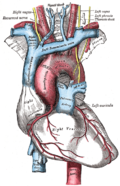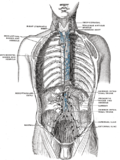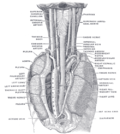Thoracic duct: Difference between revisions
CSV import |
CSV import |
||
| Line 24: | Line 24: | ||
[[Category:Lymphatic system]] | [[Category:Lymphatic system]] | ||
{{stub}} | {{stub}} | ||
<gallery> | |||
File:Gray599.png|Thoracic duct anatomy | |||
File:Gray600_color.png|Colored diagram of the thoracic duct | |||
File:Diagram_showing_the_parts_of_the_body_the_lymphatic_and_thoracic_ducts_drain_CRUK_323.svg|Diagram showing the parts of the body the lymphatic and thoracic ducts drain | |||
File:Gray503.png|Thoracic duct and surrounding structures | |||
File:Gray505.png|Thoracic duct in relation to the heart | |||
File:Gray621.png|Thoracic duct and lymphatic system | |||
File:Gray1032.png|Thoracic duct and its connections | |||
File:Photo_of_Ductus_Thoracicus_in_human_mediastinum.jpeg|Photo of ductus thoracicus in human mediastinum | |||
</gallery> | |||
Latest revision as of 10:54, 18 February 2025
Thoracic duct is the largest lymphatic vessel in the human body. It is responsible for transporting lymph from the lower and upper left quadrants of the body back to the bloodstream. The thoracic duct is a crucial part of the lymphatic system, which plays a key role in the body's immune response.
Anatomy[edit]
The thoracic duct originates in the abdomen from the confluence of the right and left lumbar trunks and the intestinal trunk, forming a significant pathway called the cisterna chyli. It traverses up through the diaphragm alongside the aorta and into the mediastinum where it drains into the venous system.
Function[edit]
The primary function of the thoracic duct is to transport lymph back to the bloodstream. Lymph is a clear, watery fluid that carries vital white blood cells that help fight infections. The thoracic duct collects lymph from the left side of the head, neck, and chest, the left upper extremity, and the entire body below the ribs. It then transports this lymph to the venous circulation at the junction of the left subclavian vein and the left internal jugular vein.
Clinical significance[edit]
Damage to the thoracic duct can result in a condition known as chylothorax, where lymph accumulates in the pleural cavity. This can occur due to surgical complications, trauma, or malignancy. Symptoms may include shortness of breath, cough, and chest pain. Treatment typically involves addressing the underlying cause and may include dietary modifications, medication, or surgery.
See also[edit]
References[edit]
<references />
|
|
|
-
Thoracic duct anatomy
-
Colored diagram of the thoracic duct
-
Diagram showing the parts of the body the lymphatic and thoracic ducts drain
-
Thoracic duct and surrounding structures
-
Thoracic duct in relation to the heart
-
Thoracic duct and lymphatic system
-
Thoracic duct and its connections
-
Photo of ductus thoracicus in human mediastinum









